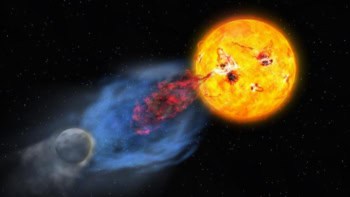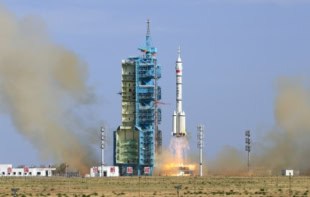
In the 400th year since Galileo pointed his first telescope heavenwards, a new way of looking at the skies — based on magnetism — could bring into focus significantly more small stars as well as planets orbiting stars other than the Sun (exoplanets).
The majority of astronomical objects are believed to possess magnetic fields. We know this because of synchrotron radiation emitted by particles trapped in them. Magnetic fields of Earth-like planets are relatively strong and are believed to originate from convection patterns in the planetary interiors. Solar magnetic fields, on the other hand — like the Sun’s — are relatively weak and thought to emerge from a layer of intense shear lying between the inner and outer sections of stars.
Now, a group of German theorists claims that this divide is too simplistic in the case of small stars and very large planets. They suggest that some planets and stars, less than a third as massive as the Sun, generate strong dipole fields like the Earth’s. If true, this would lead to very large emissions of synchrotron radiation which could be detected on earth.
This is a significant advance for it connects planetary dynamo theory to stellar dynamo theory Chris Jones, University of Leeds
Ulrich Christensen from the Max Plank Institute for Solar System Research in Northeim, Germany and his colleagues have successfully verified their model with known magnetic measurements for Jupiter, a group of young contracting stars, and a group of rapidly rotating brown dwarfs (Nature 457 167).
A matter of scale
In ‘standard’ solar dynamos, a magnetic field is generated inside the star at a region known as the ‘tachocline’; a zone dividing star interiors where conduction dominates heat transfer from the exterior where convection takes over. A sudden change in rotation rate at this layer creates high shear which intensifies a residual magnetic dynamo.
Unfortunately this model doesn’t work for certain classes of stars such as fast-rotating ones that have a mass that is less than a third of that of the Sun. Christensen and his colleagues suggest that in these cases dynamo-generating shear could originate from large-scale convection cells: regions of ionized gas rise and fall ‘rubbing shoulders’ as they pass.
This effect had been predicted previously but Christensen’s model goes much further because it also predicts the strength of field. “The key difference is our proposed scaling relationship: we directly link the energy field strength at the surface with the available energy flux from the interior,” Christensen told physicsworld.com.
Illuminate the heavens?
After correlating their model with existing observations from the T Tauri Stars and old M Dwarfs, Christensen noted that their model also requires stars and planets to be rapidly-rotating. The reason for this is yet to be fully understood.
Given these caveats, Christopher Johns-Krull of Rice University warns, “Although Christenson and colleagues’ work is an impressive step forward in our understanding of magnetic dynamo behaviour in celestial objects, it is far from a complete description of the process.”
Perhaps the most promising aspect is the radio waves stemming from strong magnetic fields. This year — the International Year of Astronomy — a new central European radio telescope array known as LOFAR will begin scanning the skies for low frequency radio waves. Christensen said, “I hope projects like LOFAR will take notice of our research and this may lead astronomers to detecting new stars and possibly extrasolar planets.”



